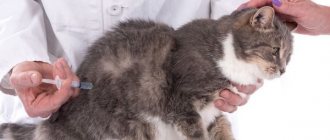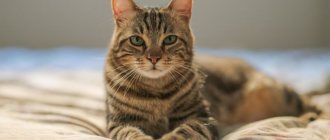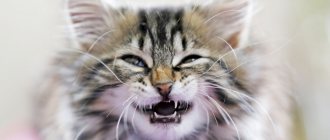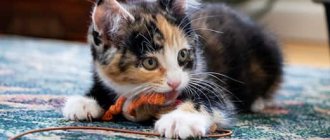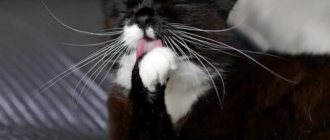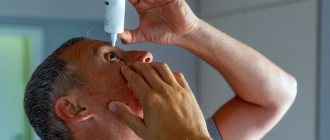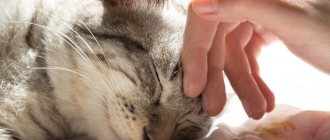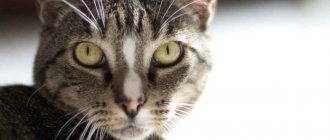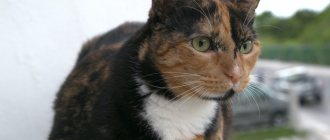- Why did the cat's fang fall out?
- How to help an animal?
- The kitten's fang fell out: what to do?
- Preventing tooth loss in cats
A tail, whiskers, claws, and sharp fangs characterize any member of the cat family. A cat without teeth looks ridiculous and strange. If a cat has lost a fang, every owner is very worried about the health of their pet. However, losing a tooth is not always a reason to panic. It is necessary to understand the reasons for this phenomenon and decide how you can help your pet.
Symptoms accompanying tooth loss
When the problem is detected at an early stage, treatment is successful. Owners monitor the behavior of their pets in order to notice the symptoms of dental disease in cats in time and begin treatment.
At the veterinarian's appointment
Chewing hurts for a cat
She refuses to eat or chews carefully so as not to touch the sore spot. Becomes aggressive and irritable. Bites and scratches the owner
Meows anxiously. He rubs his face with his paw, washes himself, shakes his head - perhaps the cat’s fang has fallen out. Sits with his mouth open.
The owner must examine the gums and tongue. If there are abscesses and bumps on the jaws, there is an unpleasant odor from the mouth - these are symptoms of diseased incisors.
Saliva flows profusely, the gums are swollen and red. Blood and pus from the mouth are a reason to seek medical help.
When an old cat’s teeth are loose, they don’t think twice about what to do - go to the veterinarian. The clinic relieves suffering for older animals.
Important! Dental problems begin gradually. An attentive owner notices symptoms in time
Treatment in the initial stages of the disease keeps the cat healthy.
What to do at home
The owner is required to strictly follow the veterinarian's instructions. Self-medication is dangerous for the cat’s health and can cause irreparable harm to it. Medicines and their dosage are determined by a specialist.
In order for the animal to lead a normal lifestyle, it is necessary to change the consistency of the food, since dry hard granules can further injure the oral cavity.
The oral cavity is regularly examined and treated with a disinfectant solution of Chlorhexidine. These procedures prevent infection of the enamel and damage to other teeth.
Features of tooth growth in kittens
An adult healthy cat has three dozen permanent teeth in its mouth (kittens have 4 fewer - 26 in total) - 12 incisors on the upper and lower jaws, 4 canines, 3 molars at the top and 4 at the bottom. And all of them should be white or cream, strong, without signs of inflammation or destruction. And the gums are pink
Much here depends on the quality of the animal’s nutrition, but it is also important on when and how the kitten’s teeth were changed and what kind of care the owners provided him during that period
When do cats' teeth change?
Owners who have recently adopted a small cat into their home constantly ask veterinarians and specialized online forums: when do kittens’ teeth change? Meanwhile, the owners will be the first to know that the pet’s incisors, canines, premolars and molars have begun to change. And to do this, you don’t even have to look into the animal’s mouth.
A kitten whose teeth change dramatically changes its own behavior. He becomes restless, meows often and loudly, informing his owners of discomfort. And the little cat begins to chew everything. Slippers - so slippers, wires - so wires, the owner's hands - that means arms, or even legs! Anything your heart desires can end up in a cat's itchy mouth. Rags, toys, books (especially those that are thicker, with “appetizing” voluminous spines), pencils and computer mice... It’s an eye-catcher!
In general, during the period when kittens’ teeth are changing, owners are required to pay close attention and control over the pet’s behavior. And also competent thoughtful care. Starting with nutrition and ending with careful hygiene of the cat’s mouth
This is necessary so that the cat’s permanent teeth grow strong and correctly, and the gums and mucous membranes remain free of inflammatory processes.
Starting with nutrition and ending with careful hygiene of the cat’s mouth. This is necessary so that the cat’s permanent teeth grow strong and correctly, and the gums and mucous membranes remain free of inflammatory processes.
At the age of 3-4 or even 5 months (much depends on the breed and on the individual development of a particular individual), cats’ teeth begin to change. This happens gradually, one might say in stages - first the incisors change, followed by the canines, and then the turn comes to the premolars and molars. And by seven months, the “dental exchange” ends in almost all domestic felines.
Of course, anyone who gets a cat must know everything about the change of teeth in kittens - when and how this happens, in order to provide special nutrition for their mustache during this period. In general, during this difficult period the animal requires special care and maximum attention from the owner.
Do kittens lose their baby teeth?
Yes, kittens are just like little guys. And tiny sharp teeth change in the same way - milk teeth fall out, permanent teeth grow. Therefore, the question that is relevant for many owners: do kittens lose their baby teeth can be answered with confidence in the affirmative. Moreover, if for some reason not all of a cat’s non-permanent teeth have fallen out, then they will have to be removed by a veterinarian.
Why delete? Yes, because excess teeth in the animal’s oral cavity can lead to injury to soft gums, the formation of wounds and ulcers on the mucous membrane. In addition, more serious problems with the bite and even with the bone tissue of the cat's jaw may arise. And such a “trifle” as periodontal disease is definitely guaranteed for your pet.
Why do new teeth emerge?
Just like in humans, kittens 4 months and older gradually replace their milky bone tissue with permanent teeth. Many owners get scared when they notice that the cat is missing one tooth or is constantly scratching its lips and gums. There is no need to worry, since such a process is completely natural and necessary. It is only important to ensure that the animal grows a new set of teeth normally and does not have double teeth, in which two teeth immediately fall out in place of one tooth. Contacting a veterinarian is also necessary in other cases:
- the resulting wounds fester and heal for a long time;
- inflammatory reaction in the gum area.
Consequences of tooth extraction
Complications are possible after the removal procedure. You will immediately understand that your animal is experiencing discomfort or pain. The cat will refuse to eat, will worry, meow loudly, and rush around the house.
Common complications include the following:
Alveolitis. Bad breath, refusal to eat, quickly swallowing pieces without chewing are signs of gum inflammation. The treatment is quick and painless. The doctor cleans the inflamed hole and applies a bandage with disinfecting ointment.
Bleeding. If there is excessive bleeding, the hole must be sutured.
Jaw fracture. It can only be detected by injury during removal, if the doctor applied too much physical force to the jaw.
Unfortunately, tooth extraction in cats is quite common, since many animal owners, out of ignorance, do not care for the cat’s oral cavity. Therefore, they come to the clinic with advanced cases and the teeth are removed.
Tooth extraction in cats occurs only when treatment no longer helps. It must be remembered that many dental diseases are asymptomatic, so it is necessary to periodically examine the oral cavity so that you do not have to resort to such a procedure.
Let's look at the cases in which teeth are removed.
- Incorrect placement of milk or molars, which interferes with the normal functioning of the animal - the soft tissues of the oral cavity are damaged.
- In severe cases, where conventional treatment has not yielded results - feline lymphoplasmacytic stomatitis.
- Teeth that are close to each other is called crowding. In this case, there is a risk of getting sick because Food will accumulate between the teeth and this will lead to an inflammatory process.
- Internal root resorption
- External root resorption
- Milk teeth that did not fall out on time on their own, but the molars have already begun to grow and the milk teeth interfere with the growth of new teeth.
- Teeth located under the gum mucosa are also subject to removal. They have not erupted, but a cyst may form under the gum and this will harm the adjacent teeth.
- The indication for tooth extraction is periodontal disease.
- Odontoclastic resorptive lesion of teeth – classes 2,3,4
Tooth extraction is carried out only under anesthesia. After tooth extraction, your pet must have the wound sutured, otherwise there is a risk of infection, and the wound will take a long time to heal.
Diet for a kitten
During the period of bone tissue formation, food should contain a sufficient amount of calcium and fluorine. A lack of mineral elements will cause delayed, uneven tooth replacement. Dry food for kittens contains all the necessary mineral supplements and will be useful as crackers for massaging swollen gums. The kitten may refuse to eat because they are sore, but this may not last long. A cat, as a predator by nature, cannot starve for more than 2 days. A small cat will only be able to skip one feeding. If he continues to starve, then you need to contact your veterinarian.
© shutterstock
Prevention of tooth loss
Preventing the loss of incisors is easier than treating a pet’s diseased chewing apparatus:
- Diet. Canned food does not clean tooth enamel. A plaque appears. Therefore, they give food with solid particles, rich in vitamins and minerals.
- Oral hygiene. Brush your teeth with a soft brush with a paste that tastes and smells like meat. This needs to be done as a daily procedure.
- Show it to the vet. He detects the problem, helps, and gives recommendations.
- Treat gum diseases. Strengthening herbal decoctions, gels, and ointments are used.
Pets suffer from toothache when the owners are not attentive enough to them: they do not notice injuries to the oral cavity, they neglect hygiene. Eating only soft canned food leads to the formation of plaque, and subsequently forms tartar. Lack of vitamins, weakened immunity, infections are the causes of dental problems.
The first signs of the disease - drooling, bleeding gums, unpleasant odor from the mouth - are a reason to consult a doctor. A good owner does not put off visiting the veterinarian and tries to cure his animal as quickly as possible.
Oral diseases in cats
For some reason, many owners are confident that kittens and adult cats a priori cannot have dental problems. Animals don’t smoke, drink coffee or eat sweets, so where do inflammatory and destructive processes in their oral cavity come from? But it turns out that anything is possible!
One of the most serious problems in a cat's mouth is tartar. But it “likes to be deposited” exactly where the gums do not fit tightly to the tooth, where there are healed wounds and ulcers. Therefore, even if kittens’ milk teeth do not fall out in a timely manner, they must be removed. The operation is simple, carried out in a veterinary office and literally in a matter of minutes. And then it’s easier for the kittens, and the owners are calmer. Including for the future of the pet.
Help with tooth loss
What to do if a kitten loses a tooth? It is difficult to give a definite answer to this question. Solution methods depend on the reason that led to the occurrence of this problem. In most cases, canine loss in a pet can be a consequence of mechanical trauma. In this situation, the breeder will need to sanitize the wound and monitor the healing process, if possible preventing the development of complications. But there are situations when it is not possible to immediately understand the cause of tooth loss in kittens. In this case, only systematic observation of animals can help. Any deviations in your pet's behavior may indicate a serious illness.
Measures to help your pet depend on the pathological or physiological process occurring in its body and may include:
· Weekly cleaning of tooth enamel.
· Therapy of carious cavities.
· Sanitation of the oral cavity.
· Balanced diet.
· Strengthening the immune system with the help of special medications.
· Therapy of the underlying pathology.
In cases where the breeder does not have sufficient experience and does not know what to do if the kitten’s teeth fall out, it is necessary to contact a veterinary clinic as soon as possible. In a specialized institution, your pet will be provided with the entire necessary range of treatment measures.
Changing baby teeth to permanent ones
The replacement of baby teeth with permanent teeth in cats begins at 4 months. The formation of the masticatory apparatus is completed at 7–8 months. The time it takes for a permanent bite to develop may vary among different cat breeds. A slight advance or delay in deadlines is allowed.
Shift order
The location and order of changing baby teeth to permanent ones is clearly depicted in the figure below. The first to fall out are the deciduous incisors. Fangs change after complete replacement of incisors. Next comes the replacement of the premolars. After a complete change, 4 molars erupt - the main chewing ones. In the picture they are colored blue.
Types of permanent teeth
An adult cat should have a total of 30 teeth. For a cat, it is a weapon, a means of protection, defense and attack. Mother cats use their front incisors to gently grab and carry the kitten.
Interesting! In cats, the lower jaw can only move in a vertical plane, so it is incorrect to say that cats chew their food. They crush it, crush it into small pieces.
The table describes the location of cat teeth, their number and functional load.
| Upper jaw | Incisors – 6 | They serve to hold prey and tear off small pieces of food. | Fangs – 2 | Used for self-defense, capturing and chopping food | Premolars – 6 Molars – 2 | They grind the bones and crush large pieces. |
| Lower jaw | Incisors – 6 | Fangs – 2 | Premolars – 4 Molars – 2 |
Molars are located deep in the jaw. Their presence indicates that the cat has become an adult. During this period, he begins to mark his territory.
When is veterinary help needed?
The owner should focus on the pet’s well-being and his own common sense. Often, symptoms when kittens change teeth make the owner worry about the baby’s health.
Veterinarians are quite loyal to situations when the owner brings a healthy kitten to the appointment to make sure that everything is fine with him. This is definitely better than not seeing a doctor when you definitely need his help.
Regarding the change of teeth, a veterinarian is definitely needed in the following situations:
- the wound on the site of the former baby tooth has festered;
- the cat meows pitifully, cannot sleep, is worried;
- the animal is very lethargic;
- the kitten does not eat for more than a day;
- the baby's mouth smells bad;
- the gums are very inflamed;
- a new tooth or an old one displaced under its influence injures the kitten;
- the baby tooth never fell out, but the gums around it were inflamed;
- the cat has not gone to the toilet for more than a day (he scratched his teeth on something, bit off a piece, and it got stuck in the intestines);
- Some of the baby teeth have not fallen out, although the permanent ones have already grown in and the time for changing teeth has passed.
Deterioration in health cannot always be attributed to the teeth; perhaps the pet is sick. A doctor's consultation will be required in the following situations:
- The smell becomes disgusting, which signals severe inflammation and the development of periodontal disease.
- The kitten sleeps poorly, does not eat for more than a day, and becomes apathetic or restless. A possible reason for this behavior is severe pain in the gums.
- Saliva is secreted excessively, thickens, hangs out of the mouth, which causes the fur on the chest to become wet. This indicates a possible inflammation of the oral mucosa - gingivitis, stomatitis.
The pet's mouth is regularly examined; normally, the surfaces remain smooth, pink, and without damage. Help is needed when deviations are noticed:
- the gum is inflamed around the temporary tooth;
- the hole festered;
- the “milk jug” has shifted and injures the mucous surfaces;
- some children’s teeth remain when the permanent ones are fully grown;
- after 7 months a double row was formed;
- The gums are red and bleeding.
In case of inflammation, they do not give medicine, but take the pet to the clinic. Only a veterinarian will be able to properly examine the mouth, assess the degree of inflammation, and prescribe medications without harm to the animal’s health. “Excess” teeth are removed in the clinic under anesthesia if they damage the mucous membranes, form an incorrect bite, or remain in the mouth after 8–9 months. Stunted growth, when milk has already fallen out, indicates a lack of microelements.
How to make the process easier
Regardless of how many months the teeth change, the owner should know that all of them should be white or cream in color, without signs of destruction or inflammation.
You also need to keep in mind that proper nutrition plays a big role in the oral health of cats. At this time, the pet should receive a complete diet and eat only healthy and good-quality food. The menu can include special supplements containing calcium and phosphorus.
Under no circumstances should you help your pet or pull out baby teeth yourself. External influence will only cause harm, loss should occur naturally, and human intervention can lead to damage to a tooth that is not yet ready to fall out.
A certain indicator indicating that a kitten is erupting permanent teeth is a particularly pungent and unpleasant odor from their mouth. In the absence of other symptoms, this should not cause concern; the unpleasant odor should go away on its own after a couple of months.
You need to regularly inspect your pet's mouth and pay attention to the gums - they should have an even structure and a uniform pink color. At this time, the baby’s gums are itching, so by the way, you will need dry food, rubber toys and special teethers that can be chewed will also come in handy. Before use, such a toy can be frozen, which will help soothe the gums.
The norm is if, when changing teeth to permanent ones, the cat refuses to eat. She experiences discomfort in her mouth and has difficulty chewing. However, if she does not eat for more than a day, then this is an alarming signal and in this case more serious health problems should be ruled out and shown to a specialist.
Cats have a special digestive system, which is characterized by the fact that prolonged fasting, lasting more than 2 days, has a negative effect on the gastrointestinal tract.
During tooth replacement, kittens' immunity decreases and they become especially susceptible to various diseases. Therefore, they need to be protected from infections and viral diseases. Under no circumstances should vaccinations be given; they create unnecessary stress on a weakened body. The baby may also become lethargic and sleep a lot.

